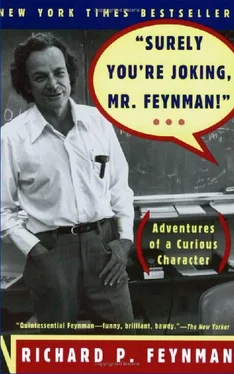Anyway we decided that the big problem—which was to figure out exactly what happened during the bomb’s implosion, so you can figure out exactly how much energy was released and so on—required much more calculating than we were capable of. A clever fellow by the name of Stanley Frankel realized that it could possibly be done on IBM machines. The IBM company had machines for business purposes, adding machines called tabulators for listing sums, and a multiplier that you put cards in and it would take two numbers from a card and multiply them. There were also collators and sorters and so on.
So Frankel figured out a nice program. If we got enough of these machines in a room, we could take the cards and put them through a cycle. Everybody who does numerical calculations now knows exactly what I’m talking about, but this was kind of a new thing then—mass production with machines. We had done things like this on adding machines. Usually you go one step across, doing everything yourself. But this was different—where you go first to the adder, then to the multiplier, then to the adder, and so on. So Frankel designed this system and ordered the machines from the IBM company because we realized it was a good way of solving our problems.
We needed a man to repair the machines, to keep them going and everything. And the army was always going to send this fellow they had, but he was always delayed. Now, we always were in a hurry. Everything we did, we tried to do as quickly as possible. In this particular case, we worked out all the numerical steps that the machines were supposed to do—multiply this, and then do this, and subtract that. Then we worked out the program, but we didn’t have any machine to test it on. So we set up this room with girls in it. Each one had a Marchant: one was the multiplier, another was the adder. This one cubed—all she did was cube a number on an index card and send it to the next girl.
We went through our cycle this way until we got all the bugs out. It turned out that the speed at which we were able to do it was a hell of a lot faster than the other way where every single person did all the steps. We got speed with this system that was the predicted speed for the IBM machine. The only difference is that the IBM machines didn’t get tired and could work three shifts. But the girls got tired after a while.
Anyway we got the bugs out during this process, and finally the machines arrived, but not the repairman. These were some of the most complicated machines of the technology of those days, big things that came partially disassembled, with lots of wires and blueprints of what to do. We went down and we put them together, Stan Frankel and I and another fellow, and we had our troubles. Most of the trouble was the big shots coming in all the time and saying, “You’re going to break something!”
We put them together, and sometimes they would work, and sometimes they were put together wrong and they didn’t work. Finally I was working on some multiplier and I saw a bent part inside, but I was afraid to straighten it because it might snap off—and they were always telling us we were going to bust something irreversibly. When the repairman finally got there, he fixed the machines we hadn’t got ready and everything was going. But he had trouble with the one that I had had trouble with. After three days he was still working on that one last machine.
I went down. I said, “Oh, I noticed that was bent.”
He said, “Oh, of course. That’s all there is to it!” Bend! It was all right. So that was it.
Well, Mr. Frankel, who started this program, began to suffer from the computer disease that anybody who works with computers now knows about. It’s a very serious disease and it interferes completely with the work. The trouble with computers is you play with them. They are so wonderful. You have these switches—if it’s an even number you do this, if it’s an odd number you do that—and pretty soon you can do more and more elaborate things if you are clever enough, on one machine.
After a while the whole system broke down. Frankel wasn’t paying any attention; he wasn’t supervising anybody. The system was going very, very slowly—while he was sitting in a room figuring out how to make one tabulator automatically print arc-tangent X, and then it would start and it would print columns and then bitsi, bitsi, bitsi, and calculate the arc-tangent automatically by integrating as it went along and make a whole table in one operation.
Absolutely useless. We had tables of arc-tangents. But if you’ve ever worked with computers, you understand the disease—the delight in being able to see how much you can do. But he got the disease for the first time, the poor fellow who invented the thing.
I was asked to stop working on the stuff I was doing in my group and go down and take over the IBM group, and I tried to avoid the disease. And, although they had done only three problems in nine months, I had a very good group.
The real trouble was that no one had ever told these fellows anything. The army had selected them from all over the country for a thing called Special Engineer Detachment—clever boys from high school who had engineering ability. They sent them up to Los Alamos. They put them in barracks. And they would tell them nothing.
Then they came to work, and what they had to do was work on IBM machines—punching holes, numbers that they didn’t understand. Nobody told them what it was. The thing was going very slowly. I said that the first thing there has to be is that these technical guys know what we’re doing. Oppenheimer went and talked to the security and got special permission so I could give a nice lecture about what we were doing, and they were all excited: “We’re fighting a war! We see what it is!” They knew what the numbers meant. If the pressure came out higher, that meant there was more energy released, and so on and so on. They knew what they were doing.
Complete transformation! They began to invent ways of doing it better. They improved the scheme. They worked at night. They didn’t need supervising in the night; they didn’t need anything. They understood everything; they invented several of the programs that we used.
So my boys really came through, and all that had to be done was to tell them what it was. As a result, although it took them nine months to do three problems before, we did nine problems in three months, which is nearly ten times as fast.
But one of the secret ways we did our problems was this. The problems consisted of a hunch of cards that had to go through a cycle. First add, then multiply—and so it went through the cycle of machines in this room, slowly, as it went around and around. So we figured a way to put a different colored set of cards through a cycle too, but out of phase. We’d do two or three problems at a time.
But this got us into another problem. Near the end of the war, for instance, just before we had to make a test in Albuquerque, the question was: How much energy would be released? We had been calculating the release from various designs, but we hadn’t computed for the specific design that was ultimately used. So Bob Christy came down and said, “We would like the results for how this thing is going to work in one month”—or some very short time, like three weeks.
I said, “It’s impossible.”
He said, “Look, you’re putting out nearly two problems a month. It takes only two weeks per problem, or three weeks per problem.”
I said, “I know. It really takes much longer to do the problem, but we’re doing them in parallel. As they go through, it takes a long time and there’s no way to make it go around faster.”
Читать дальше












